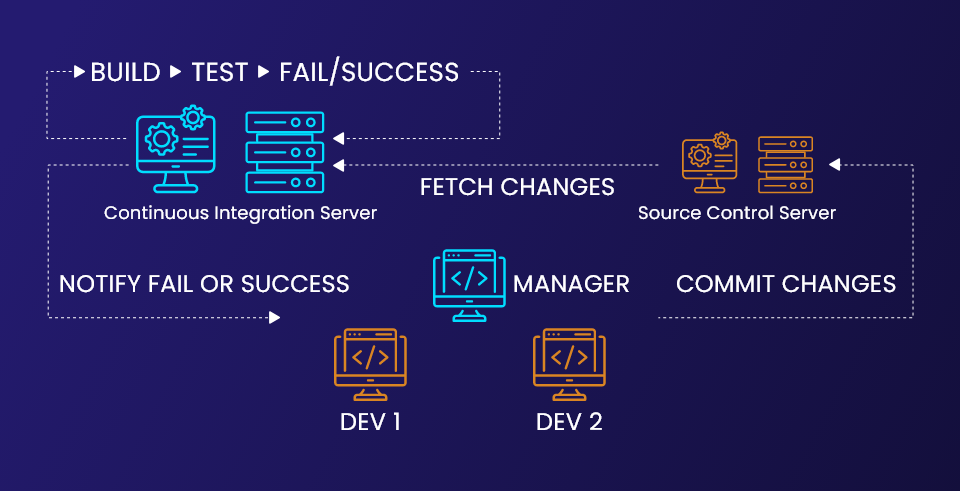CICD introduces agile practices to the product development culture and brings in interesting features like automated builds, automated testing, continuous integration, and continuous testing. The CICD pipeline is a significant feature of the broader DevOps/DevSecOps framework.
What Is CICD?
CI stands for continuous integration while CD stands for continuous deployment and delivery. CI/CD enables organizations to swiftly and effectively deploy software. It establishes an efficient approach for expediting product launches, constantly releasing code to production, and guaranteeing a seamless stream of novel features and bug fixes through the most optimal delivery mechanism.

Continuous integration
Continuous integration is the process of making iterative checks and integration of code to a repository upon small developments. The code is then tested for bugs or failure. This creates a culture of progressing development through small increments under continuous watch instead of delivering large amount of code all at once after a long wait.
Continuous delivery
Continuous delivery ensures supply of completed code for testing and subsequent release into production. CD ensures automatic production of releases at regular intervals in a disciplined manner.
Continuous deployment
This is the subsequent process of continuous delivery. Every change that successfully passes the tests is automatically deployed into production.
Continuous deployment is a goal for most companies provided there are no limitations posed from government regulations and tests to be performed which cannot be automated.
CI/CD Stages for Building an Application
The CICD process must be implemented through every stages of an application development. This can majorly be broken down into seven stages.
Code
Developers code and push their changes to the central repository frequently. This triggers an automated process where the CI server (like Jenkins, Travis CI, CircleCI, etc.) fetches the latest code from the repository.
Build
This is the stage when the app is built. The CI server compiles the code to identify syntax errors and potential build issues. Output of this stage is a URL.
Test
A suite of automated tests (unit tests, integration tests, etc.) is executed to verify that the new code integrates correctly with the existing codebase without breaking anything. The CI software offers developers insights into the application’s performance and provides valuable analytics alongside.
Package
At this stage, CI/CD tools and automation ensure that the application is packaged correctly, tested thoroughly, and deployed consistently. This approach reduces deployment-related errors, ensures version consistency, and facilitates smooth releases of the application to production environments.
Release
Once all these stages are successfully passed it is the time to release the product in compatible devices and environments. This is an automated process taken care of by the CI/CD pipeline.
Configuration
This phase focuses on managing the underlying infrastructure that supports the application’s deployment, ensuring its scalability, reliability, and performance. Some of the important tasks of this phase are environment provisioning, configuration management, infrastructure update and patching.
Monitor
At this stage, monitoring tools are set up to track the health, performance, and availability of the application and its infrastructure. Logging systems are configured to capture and store logs, facilitating troubleshooting and debugging in case of issues.
Benefits of CICD Implementation in Product Development
Faster feedback
CI/CD automates the process of integrating code changes, running tests, and deploying to testing environments. Developers receive immediate feedback on the quality and functionality of their code, allowing them to address issues early in the development cycle.
High transparency
When the CI/CD pipeline is set up the entire team is working on a common repository and are aware of the changes and active issues. This allows them to plan ahead and also helps to easily detect changes that breaks the build often.
Automatic integration
Automatic integration is at the crux of a CICD pipeline. Automatic integration helps to relieve the workload of developers and saves a lot of time which would be otherwise wasted on manually integrating new changes. Automated integration reduces integration conflicts and ensures that code remains cohesive and functional across the development team.
Early issue detection
Automated testing is an integral part of CI/CD pipelines. Code changes are subjected to various automated tests, including unit tests, integration tests, and regression tests, which identify issues and bugs early in the development process. Early detection allows developers to address issues before they become more complex and costly to fix.
Improved QA
Automated testing integrated within the CI/CD process offers a multitude of advantages for quality assurance in application development. It ensures consistent and reliable testing, providing immediate feedback and catching defects early in the development cycle. With comprehensive regression testing, it guards against unintended regressions. By covering a broad range of scenarios and executing swiftly, it minimizes human error, accelerates testing, and facilitates parallel and scalable assessments, which would be impossible to achieve manually.
Tips to select the appropriate CICD tools
Proprietary vs. Open source
Sometimes a proprietary tool might be out of budget and the client needs to go for open source tools. A plethora of open source tools are available in the market from providers like AWS or Azure but while selecting one extra care must be taken to check if they violate any compliance or regulatory requirements.
Cloud vs. On premises
Configuring, hosting, and managing a CICD service on premise is a cumbersome and costly job. This will certainly involve dedicated resources and technical expertise. If the client is not barred to leverage third party cloud services and tools many excellent solutions can come from leveraging cloud-native tools.
Active support
When looking for third party cloud solutions it is important to check the active support they can provide, their expertise in DevOps culture, and overall industry experience. CICD is a continuous process so once it breaks, immediate response is crucial to save the production going off the rails.
Conclusion
Automated testing facilitates uninterrupted delivery, guaranteeing software quality and security while enhancing the profitability of deployed code. Leveraging CI/CD pipelines leads to a significantly reduced time-to-market for novel product features, resulting in heightened customer satisfaction and reduced pressure on development teams.
